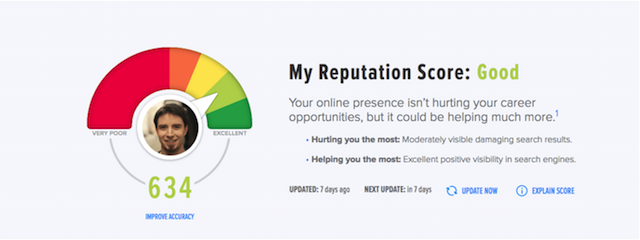
Navigating BrandYourself’s New Software Update
The new version of BrandYourself provides much more comprehensive technology to help you clean up and improve your online presence. This quick guide explains your new features and how to find all the information you had in your old account (if you already had one).
What this guide covers:
- What’s new in this version?
- How is my new Reputation Score different from my old Search Score?
- Where is the info that was on my old Report Card?
- Where can I find all my submitted links?
- Where can I submit new links?
- Where can I find my profile visitors?
- How can I edit my BrandYourself profile?
Your Reputation Score replaces your old Search Score

Your new Reputation Score gauges how your entire online presence helps or hurts your career – think of it like a credit score for your online presence. It identifies factors that are putting your career at risk, including potentially damaging search results, risky social media posts, and inappropriate social media images. It also looks at positive information about you on the web that benefits your career, like well-optimized and up-to-date properties. Your new Reputation Score is a numeric value, with the highest possible score being 800. We also provide a range of “very poor” to “excellent” as a guide to show how you stack up.
What to expect: Your new Reputation Score may be lower than your previous Search Score
You may notice that your new Reputation Score is comparatively lower than your previous Search Score that gave you a letter grade – that’s ok! Your Search Score only rated the first page of search results. Your new Reputation Score looks at your entire online presence, including search results, social media posts, and images. As online screening becomes more and more prominent, employers are now looking beyond just search results.
Your Reputation Report replaces your old Report Card
When you first log in, you’re brought to your Reputation Report – this is your dashboard. In the previous version, the information housed here was known as your “Report Card”. The Reputation Report provides an overview of your online presence, including:
- Your Reputation Score
- A summary of your risk factors (search results, social posts, and images)
- A summary of your personal brand (how many high-quality properties you’ve created and kept updated)
- A summary of your Google results
- Your BrandYourself profile visitors
- Your new Earnability Calculator, which quantifies how your online presence could be impacting your earning potential
Your Reputation Builder offers powerful new features to improve your score while “Properties” replaces your old My Links page
Your Reputation Builder section is where you can take action to improve your Reputation Score. That includes building your personal brand and cleaning up risk factors.
Your new Reputation Builder includes:
- Action Plan: This lists the steps you can take to improve your Reputation Score.
- Risk Factors:
- Search Results. This lists any Google results that could be flagged by employers during an online screening and damage your reputation. It also shows you how to suppress them by building positive content.
- Social Posts. This scans your social media profiles for any posts that could be flagged by employers as unprofessional during an online screening, and helps you delete them.
- Images. This scans your social media profiles for any images that could be flagged by employers as unprofessional during an online screening, and helps you delete them.
- Personal Brand: This is where you can edit and view your BrandYourself profile.
Your new Properties page:
- This is where you’ll find all your links (it replaces your old My Links page). It walks you through the process of building a positive personal brand to improve your Reputation Score. Your customized personal brand plan takes into account your industry and your current Reputation Score to provide a list of recommended properties that you should build. It then shows you how to optimize them and keep them updated over time.
FAQs
Where is the info from my old “Report Card”?
Most info from your old Report Card can now be found on your Reputation Report, including an overview of your Reputation Score, a summary of your visibility in Google, and your profile visitors. It also includes new information including a summary of your risk factors and a summary of your personal brand.
Where is the “My Links” page? Where are all my submitted links, and where do I submit new ones?
Your Properties page completely replaces your old My Links page. It lists all the links you’ve submitted, how well optimized they are, and how updated they are. You can also add additional links by scrolling down to the “Other Properties” section and submitting them in the input box, just like in the old version.
Where are my BrandYourself profile visitors?
Your Reputation Report shows your profile visitors. Just scroll down to the “Online Audience” section to see who’s viewed your profile recently. We changed the name because this section will show more info about your online audience in the future. But for now, it just shows your BrandYourself profile visitors.
How can I edit my BrandYourself profile?
Edit and view your profile on your Profile page here. Click the “Reputation Builder” tab in the main navigation, then look for “Profile” under the “Personal Brand” subheading.
Where can I find my Google results?
Your Google Visibility page shows the top 10 pages of Google results for your name. Here you can mark each result as “Positive”, “Damaging”, or “Not Me.” We’ll also notify you of any potentially damaging search results our technology flags in your Flagged Search Results section.
Why is my Reputation Score lower than my Search Score?
You may notice that your new Reputation Score is comparatively lower than your previous Search Score that gave you a letter grade – that’s ok! Your Search Score only rated the first page of search results. Your new Reputation Score looks at your entire online presence, including search results, social media posts, and images. As online screening becomes more and more prominent, employers are now looking beyond just search results.
